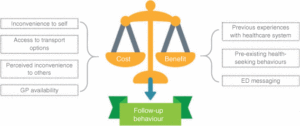 This paper was published (initially as early access online) by the Australian Journal of Primary Health on 28 September 2020. This has been published as open access, and the full-text and PDF are available from the journal website: https://doi.org/10.1071/PY19221
This paper was published (initially as early access online) by the Australian Journal of Primary Health on 28 September 2020. This has been published as open access, and the full-text and PDF are available from the journal website: https://doi.org/10.1071/PY19221
Hanna S, Tam CWM, Knight A, Zhao L, Ban L, Pellizzon B, Parks J. The ED2GP (emergency department to general practice) for Women study: understanding lower follow-up rates among older women. Australian Journal of Primary Health. 2020; 26(5): 396-401. DOI: https://doi.org/10.1071/PY19221
Abstract
Older women seem to have lower GP follow-up rates after an emergency department (ED) discharge than men. This qualitative study investigated how older women seek GP follow up after an ED visit. In 2018, women aged ≥65 years were recruited from an ED in a suburban hospital in south-western Sydney, Australia, and then contacted 1 week later for a telephone interview exploring factors associated with their follow-up behaviour. Grounded theory was used to construct a potential explanatory model of follow-up behaviours. Of the 100 women recruited, 64% had attended a GP follow up by Day 7, as instructed. The balance of perceived cost and benefit of GP follow up emerged as a useful model to understand the factors affecting follow-up behaviour. Perceived costs included inconvenience caused to self and others, access to transport options and the availability of a patient’s GP. Perceived benefits included previous experiences with the healthcare system, pre-existing health-seeking behaviours and ED messaging. Our findings suggest that follow-up rates could be improved by strengthening the perceived benefit of GP follow up at the point of ED discharge, in addition to addressing perceived costs. Approaches may include ensuring discharge instructions are purposeful and given in the company of an older woman’s social supports.
